Analysis of Regional Differences in Asphalt Binder Under All-Weather Aging Based on Rheological and Chemical Properties
Abstract
1. Introduction
2. Materials and Methods
2.1. Raw Materials
2.2. Laboratory Accelerated Aging Tests
2.3. Natural Exposure Aging Tests
2.3.1. Climatic Characteristics of Different Regions
2.3.2. Preparation and Processing of AWA Samples
2.4. Characterization Methods of Rheological Properties
- (1)
- Intermediate-temperature fatigue resistance
- (2)
- Low-temperature cracking resistance
2.5. Characterization Method of Chemical Composition
3. Results and Discussion
3.1. The Effect of AWA on Rheological Properties of Asphalt Binders
3.1.1. Evolution of Intermediate-Temperature Fatigue Resistance
3.1.2. Evolution of Low-Temperature Cracking Resistance
3.2. The Effect of AWA on Chemical Functional Groups of Asphalt Binders
3.3. Correlation Analysis of Macro and Micro Performance Indexes
3.4. Correlation Analysis Between AWA Factors and Asphalt Binder Performance Across Regions
4. Conclusions
- All-weather aging patterns exhibited significant regional disparities. In Gansu, extreme temperature fluctuations and intense UV radiation caused 52.4% higher G-R parameter than PAV. In Shandong, hygrothermal–salt fog interactions promoted Cl−-induced electrochemical corrosion, leading to 4.2% higher IS=O in SD-A12 than PAV. In Beijing, a synergistic effect of UV–thermal oxidation increased the S-value by 40.7% in BJ-A12 compared to PAV. Notably, all-weather aging in Beijing and Gansu induced more severe rheological degradation than PAV, while Shandong showed closer alignment, emphasizing region-dependent aging severity beyond laboratory simulation.
- Chemical oxidation exhibited robust correlations with rheological properties degradation across all regions. IC=O of BJ-A12 was highly linked with G-R parameter (r = 0.94) and S-value (r = 0.93), directly connecting oxygenated groups to hardening and performance degradation. Additionally, 49.5% faster C=O generation of GS-A12 than Shandong indicated that UV radiation prompted oxidation. Based on IC=O, the 12-month all-weather aging rate in Beijing surpassed Gansu and Shandong by 18.5% and 68%, respectively, demonstrating that UV–thermal oxidation coupling effects led to the most severe degradation pattern in Beijing.
- Environmental parameters exhibited significant regional variations in impact intensity. Under all-weather conditions, UV radiation and temperature difference significantly accelerated aging in Gansu and Beijing (r > 0.6), with GS-A6 achieving 74% G-R parameter of PAV and BJ-A6 showing 26.1% higher S-value than PAV. The climatic stability of Shandong reduced thermal aging but displayed strong precipitation–carbonyl correlations (r > 0.7), with UV as a secondary factor. Yet crucially, multi-factor coupling effects resulted in aging rather than a single factor. Aging time impacted regions differently (Beijing > Gansu > Shandong).
- It is noted that the indoor laboratory aging test (TFOT, PAV) in this study primarily simulated thermo-oxidative effects. Future research should incorporate multi-factor coupling (e.g., UV, moisture) to better simulate complex field environments. Future studies should extend aging time to capture long-term degradation, and develop region-specific anti-aging modifiers targeting dominant environmental stressors (e.g., UV stabilizers for Beijing and chloride inhibitors for Shandong).
Author Contributions
Funding
Institutional Review Board Statement
Informed Consent Statement
Data Availability Statement
Acknowledgments
Conflicts of Interest
Abbreviations
| AWA | All-weather aging |
| NEA | Natural exposure aging |
| MFA | Multi-factor accelerating |
| UV | Ultraviolet |
| RTFOT | Rolling thin film oven test |
| TFOT | Thin film oven test |
| GS | Gansu region |
| SD | Shandong region |
| BJ | Beijing region |
| GS-A12 | Asphalt binders after 12-month all-weather aging in Gansu |
| DSR | Dynamic shear rheometer |
| BBR | Bending beam rheometer |
| FTIR | Fourier transform infrared spectroscopy |
| G-R | Glover-Rowe |
| S-value | Stiffness modulus |
| IC=O | Carbonyl index |
| IS=O | Sulfoxide index |
| MMTD | Monthly mean temperature difference |
| MMUVR | Monthly mean ultraviolet radiation |
| MMP | Monthly mean precipitation |
References
- Guo, M.; Liang, M.C.; Liu, H.; Bi, Y.F.; Du, X.L. Study on the effect of different environmental factors on the aging gradient of asphalt binder based on field aging test. Int. J. Pavement Eng. 2023, 24, 2245950. [Google Scholar] [CrossRef]
- Ahmad, M.; Khedmati, M.; Mensching, D.; Hofko, B.; Haghshenas, H.F. Aging characterization of asphalt binders through multi-aspect analyses: A critical review. Fuel 2024, 376, 132679. [Google Scholar] [CrossRef]
- Wu, M.; Yin, L.; Li, M.; You, Z.; Jin, D.; Xin, K. A state-of-the-art review of asphalt aging behavior at macro, micro, and molecular scales. Constr. Build. Mater. 2025, 460, 139738. [Google Scholar] [CrossRef]
- Zhao, K.; Wang, Y. Influences of aging conditions on the rheological properties of asphalt binders. Int. J. Pavement Eng. 2018, 21, 653–665. [Google Scholar] [CrossRef]
- Zhang, K. Evaluation of aging evolution of olive pomace–modified asphalt binders under natural weather aging conditions. J. Test. Eval. 2023, 51, 3933–3946. [Google Scholar] [CrossRef]
- Chen, Z.; Zhang, H.; Duan, H.; Wu, C.; Zhang, S. Long-term photo oxidation aging investigation of temperature-regulating bitumen based on thermochromic principle. Fuel 2021, 286, 119403. [Google Scholar] [CrossRef]
- Zhang, D.; Zheng, Y.; Yuan, G.; Guo, H.; Zhou, Q.; Qian, G.; Liang, B. Comparative analysis of rheological and microscopic performance of SBS modified asphalt based on field aging and laboratory aging. Fuel 2023, 352, 128933. [Google Scholar] [CrossRef]
- Chen, M.; Geng, J.; Chen, H.; Niu, Y.; He, L. Micro-characterization of bitumens under the coupling action of moisture and oxygen. J. Build. Eng. 2022, 53, 104589. [Google Scholar] [CrossRef]
- Geng, J.; Meng, H.; Xia, C.; Chen, M.; Lu, T.; Zhou, H. Effect of dry–wet cycle aging on physical properties and chemical composition of SBS-modified asphalt binder. Mater. Struct. 2021, 54, 120. [Google Scholar] [CrossRef]
- Li, Q.; Zeng, X.; Wang, J.; Luo, S.; Meng, Y.; Gao, L.; Wang, X. Aging performance of high viscosity modified asphalt under complex heat-light-water coupled conditions. Constr. Build. Mater. 2022, 325, 126314. [Google Scholar] [CrossRef]
- Liang, M.; Guo, M.; Xu, X.; Liu, X.; Liu, H.; Bi, Y. Study on accelerated aging rate of asphalt binder under multi-factors coupling conditions. Constr. Build. Mater. 2023, 400, 132819. [Google Scholar] [CrossRef]
- Ran, L.; Li, Q.; Luo, W.; Xu, H.; Kong, L. Viscoelastic Behavior and Characterization of Bitumen under Natural Exposure Aging in the Tibetan Areas. J. Mater. Civ. Eng. 2024, 36, 04024020. [Google Scholar] [CrossRef]
- Bi, Y.; Xu, Y.; Li, B.; Zou, X.; Gao, J.; Li, Q. Laboratory-accelerated simulation and calibration method for ultraviolet aging of asphalt binders based on radiation equivalent conversion. Constr. Build. Mater. 2024, 435, 136791. [Google Scholar] [CrossRef]
- Bi, Y.; Xu, Y.; Chen, Z.; Zou, X.; Li, B.; Gao, J.; Geng, X. Aging behavior and self-healing properties of asphalt binders in high-altitude environments. Constr. Build. Mater. 2025, 475, 141271. [Google Scholar] [CrossRef]
- Wu, S.P.; Pang, L.; Mo, L.T.; Chen, Y.C.; Zhu, G.J. Influence of aging on the evolution of structure, morphology and rheology of base and SBS modified bitumen. Constr. Build. Mater. 2009, 23, 1005–1010. [Google Scholar] [CrossRef]
- Martínez-Toledo, C.; Valdés-Vidal, G.; Calabi-Floody, A.; González, M.E.; Reyes-Ortiz, O. Effect of biochar from oat hulls on the physical properties of asphalt binder. Materials 2022, 15, 7000. [Google Scholar] [CrossRef]
- Liang, M.; Guo, M.; Tan, Y.; He, S.; Du, X. Evaluation of anti-ageing performance of bitumen based on rheological and chemical characterisation. Int. J. Pavement Eng. 2023, 24, 2213385. [Google Scholar] [CrossRef]
- Kadhim, H.J.; Modarres, A.; Al-Busaltan, S. Rheological and microstructural properties of nano-composite bitumen modified by nano-alumina and low-SBS content. Case Stud. Constr. Mater. 2024, 20, e03244. [Google Scholar] [CrossRef]
- Menapace, I.; Yiming, W.; Masad, E. Effects of environmental factors on the chemical composition of asphalt binders. Energy Fuels 2018, 33, 2614–2624. [Google Scholar] [CrossRef]
- Lopes, A.S.; Neto, O.D.M.M.; Lucena, L.C.F.L.; Nascimento, M.D.V.D.; Siqueira, M.V.; Sousa, T.M.; Monteiro, A.F.F. Impact of aging protocols on asphalt binder behavior: A laboratory and field study. Case Stud. Constr. Mater 2023, 19, e02629. [Google Scholar]
- Yang, H.; Pang, L.; Zou, Y.; Liu, Q.; Xie, J. The effect of water solution erosion on rheological, cohesion and adhesion properties of asphalt. Constr. Build. Mater. 2020, 246, 118465. [Google Scholar] [CrossRef]
- Kanitpong, K.; Bahia, H. Relating adhesion and cohesion of asphalts to the effect of moisture on laboratory performance of asphalt mixtures. Transp. Res. Rec. 2005, 1901, 33–43. [Google Scholar] [CrossRef]
- Roja, K.L.; Masad, E. Influence of chemical constituents of asphalt binders on their rheological properties. Transp. Res. Rec. 2019, 2673, 458–466. [Google Scholar] [CrossRef]
- ASTM D5/D5M-23; Standard Test Method for Penetration of Bituminous Materials. ASTM International: West Conshohocken, PA, USA, 2023.
- ASTM D36/D36M-14; Standard Test Method for Softening Point of Bitumen (Ring-and-Ball Apparatus). ASTM International: West Conshohocken, PA, USA, 2014.
- ASTM D113-23; Standard Test Method for Ductility of Asphalt Materials. ASTM International: West Conshohocken, PA, USA, 2023.
- ASTM D4402/D4402M-23; Standard Test Method for Viscosity Determination of Asphalt at Elevated Temperatures. ASTM International: West Conshohocken, PA, USA, 2023.
- JTG E20-2011; Standard Test Methods of Bitumen and Bituminous Mixtures for Highway Engineering. Ministry of Transport of the People’s Republic of China: Beijing, China, 2011.
- Guo, M.; Guan, M.; Tan, Y.; Du, X. Using rheology to study the effect of aging on fatigue performance of asphalt binder. Road Mater. Pavement Des. 2025, 1–21. [Google Scholar] [CrossRef]
- Rowe, G.M.; King, G.; Anderson, M. The influence of binder rheology on the cracking of asphalt mixes in airport and highway projects. J. Test. Eval. 2014, 42, 1–10. [Google Scholar] [CrossRef]
- Safaei, F.; Castorena, C. Material nonlinearity in asphalt binder fatigue testing and analysis. Mater. Des. 2017, 133, 376–389. [Google Scholar] [CrossRef]
- Riccardi, C.; Indacoechea, I.; Wang, D.; Lastra-González, P.; Falchetto, A.C.; Castro-Fresno, D. Low temperature performances of fiber-reinforced asphalt mixtures for surface, binder, and base layers. Cold Reg. Sci. Technol. 2023, 206, 103738. [Google Scholar] [CrossRef]
- Marasteanu, M.; Ghosh, D.; Cannone Falchetto, A.; Turos, M. Testing protocol to obtain failure properties of asphalt binders at low temperature using creep compliance and stress-controlled strength test. Road Mater. Pavement Des. 2017, 18 (Suppl. 2), 352–367. [Google Scholar] [CrossRef]
- Moon, K.H.; Falchetto, A.C.; Hu, J.W. Investigation of asphalt binder and asphalt mixture low temperature creep properties using semi mechanical and analogical models. Constr. Build. Mater. 2014, 53, 568–583. [Google Scholar] [CrossRef]
- Le, T.H.; Chan, T.; Kurokawa, Y.; Inoue, H. Numerical simulation of deformation-induced temperature variations of a rubber ball under cyclic compression. Int. J. Solids Struct. 2022, 248, 111664. [Google Scholar] [CrossRef]
- Kocak, S.; Kutay, M.E. Effect of devulcanized rubber modification on the performance grade, fatigue cracking resistance, and rutting resistance of asphalt binders. J. Mater. Civ. Eng. 2021, 33, 04021248. [Google Scholar] [CrossRef]
- Teshale, E.Z.; Moon, K.H.; Turos, M.; Marasteanu, M. Pressure aging vessel and low-temperature properties of asphalt binders. Transp. Res. Rec. 2011, 2207, 117–124. [Google Scholar] [CrossRef]
- Yu, T.; Chen, Z.; Zhao, F.; Ji, X.; Wang, M. Analysis of gestation, emergence and development behavior for asphalt microcrack topography based on FEM-MD. Fuel 2025, 395, 135271. [Google Scholar] [CrossRef]
- Meng, Y.; Yao, Q.; Mo, S.; Zhang, C.; Tan, S.; Wei, L. The influence of acid rain on asphalt and its mixture performance, simulation and micro-mechanism exploration. Fuel 2025, 379, 133010. [Google Scholar] [CrossRef]
- Berkowitz, M.; Filipovich, M.; Baldi, A.; Hesp, S.A.; Aguiar-Moya, J.P.; Loría-Salazar, L.G. Oxidative and thermoreversible aging effects on performance-based rheological properties of six Latin American asphalt binders. Energy Fuels 2019, 33, 2604–2613. [Google Scholar] [CrossRef]
- Abdrabou, M.K.; Han, X.; Zeng, Y.; Zheng, Y. Optimization of iron-based catalyst for partial upgrading of Athabasca Bitumen: The role of Fe oxidation state, particle size, and concentration. Fuel 2024, 357, 129941. [Google Scholar] [CrossRef]
- Yang, B.; Li, H.; Sun, Y.; Zhang, H.; Liu, J.; Yang, J.; Zhang, X. Chemo-rheological, mechanical, morphology evolution and environmental impact of aged asphalt binder coupling thermal oxidation, ultraviolet radiation and water. J. Clean. Prod. 2023, 388, 135866. [Google Scholar] [CrossRef]
- Li, Y.; Li, H.; Nie, S.; Wu, S.; Liu, Q.; Li, C.; Shu, B.; Li, C.; Song, W.; Pang, L. Negative impacts of environmental factors (UV radiation, water and different solutions) on bitumen and its mechanism. Constr. Build. Mater. 2020, 265, 120288. [Google Scholar] [CrossRef]
- Qian, G.; Yu, H.; Jin, D.; Bai, X.; Gong, X. Different water environment coupled with ultraviolet radiation on ageing of asphalt binder. Road Mater. Pavement Des. 2020, 22, 2410–2423. [Google Scholar] [CrossRef]
- Lin, J.; Hong, J.; Liu, J.; Wu, S. Investigation on physical and chemical parameters to predict long-term aging of asphalt binder. Constr. Build. Mater. 2016, 122, 753–759. [Google Scholar] [CrossRef]
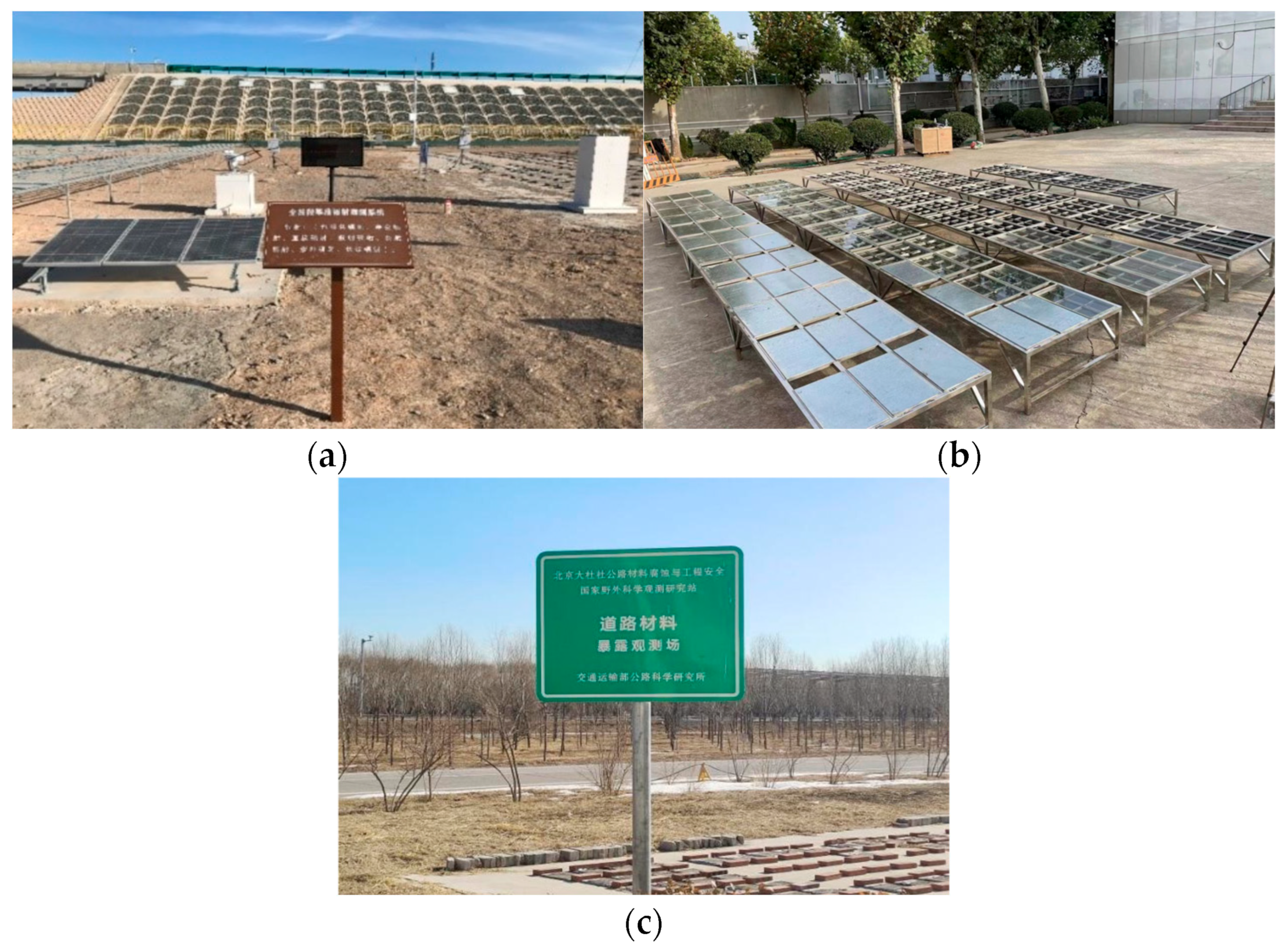
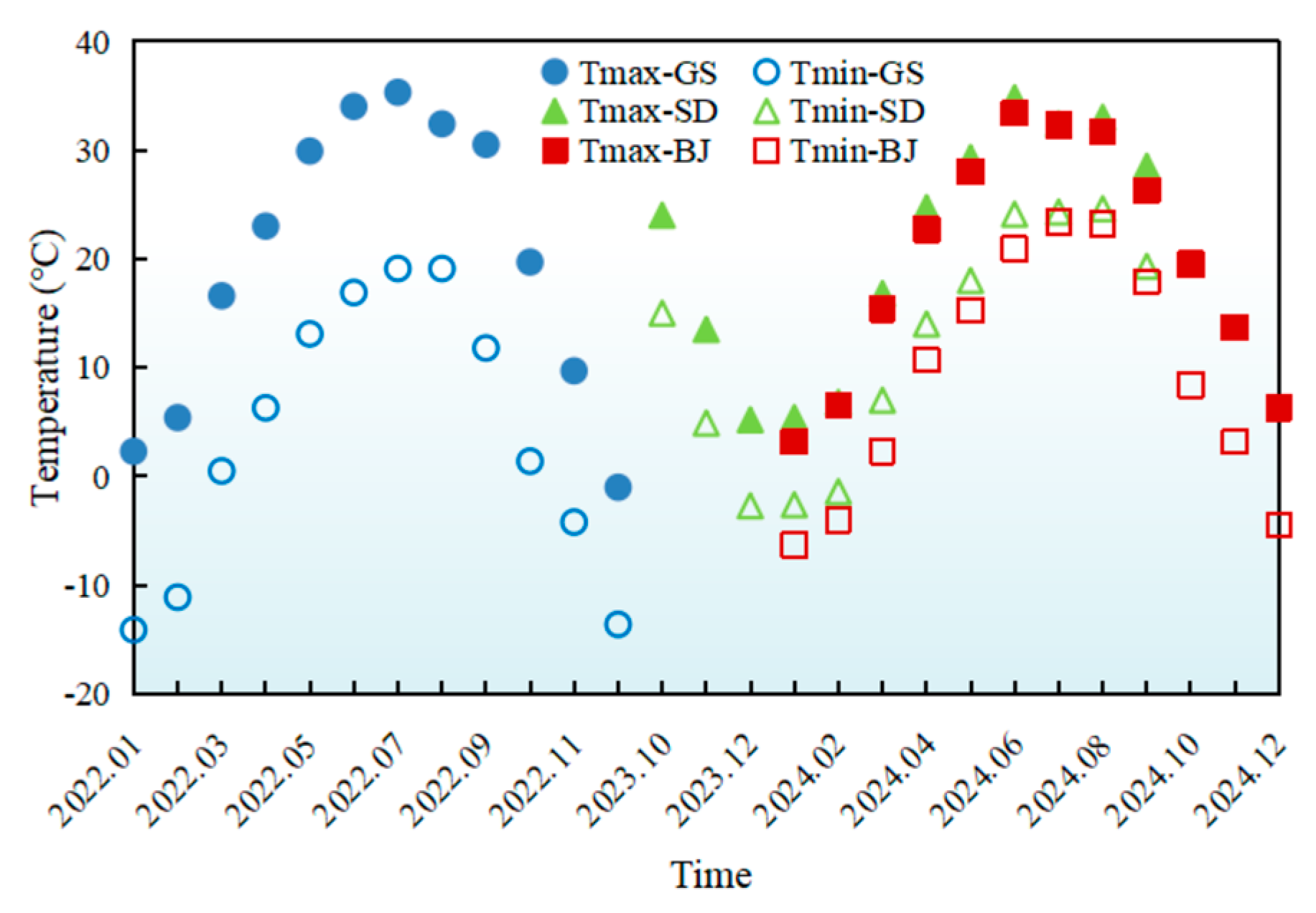

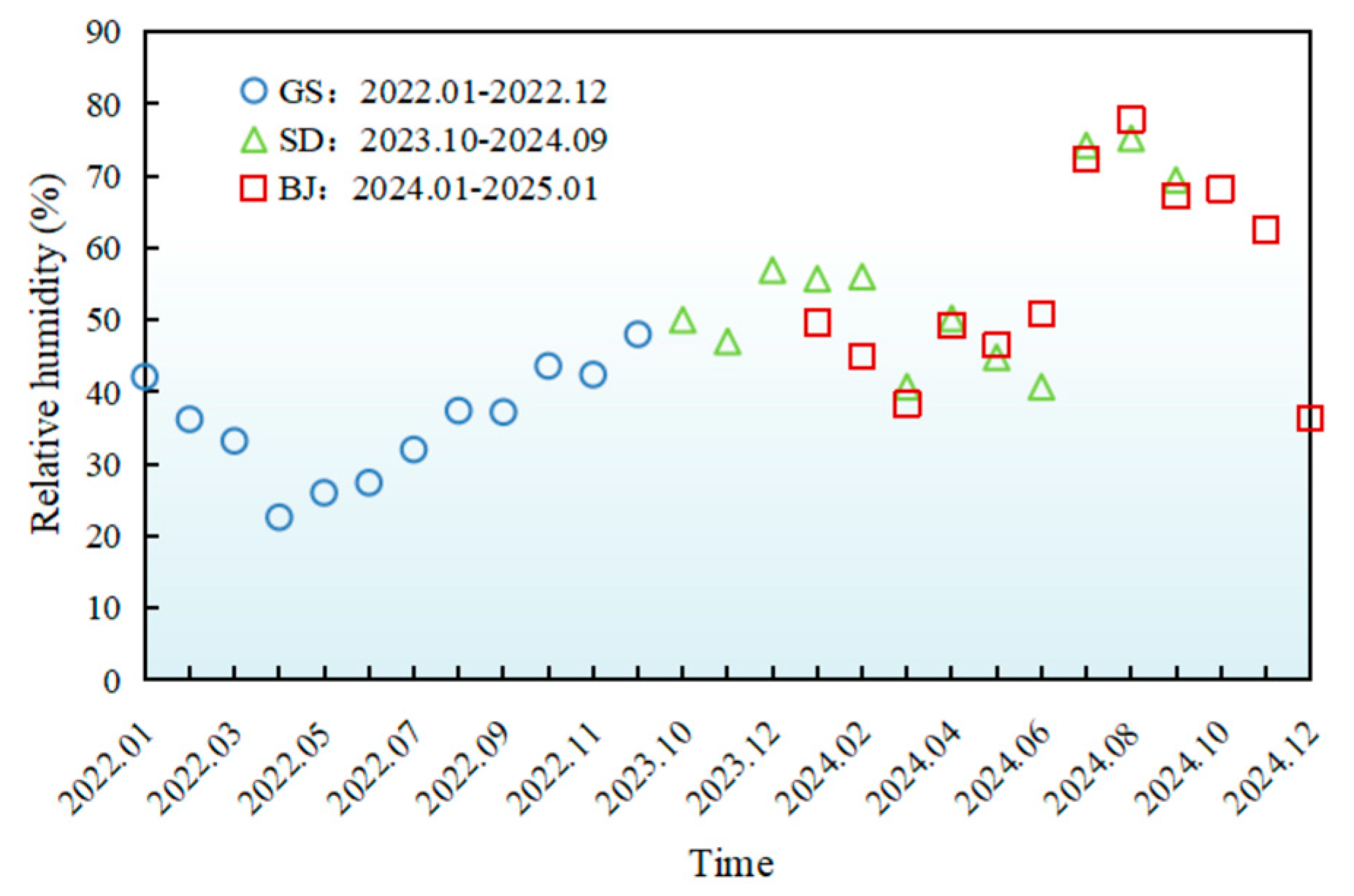
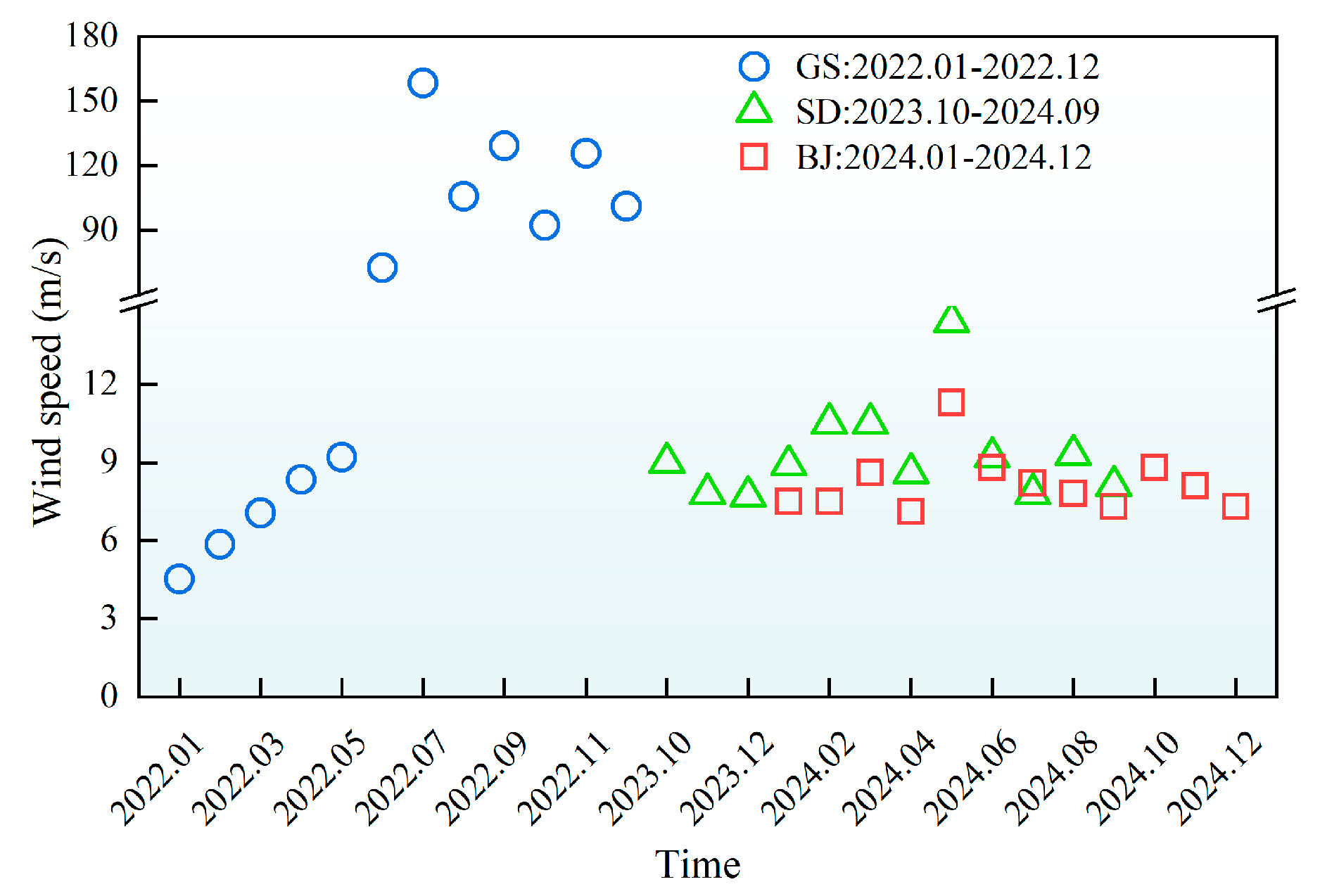
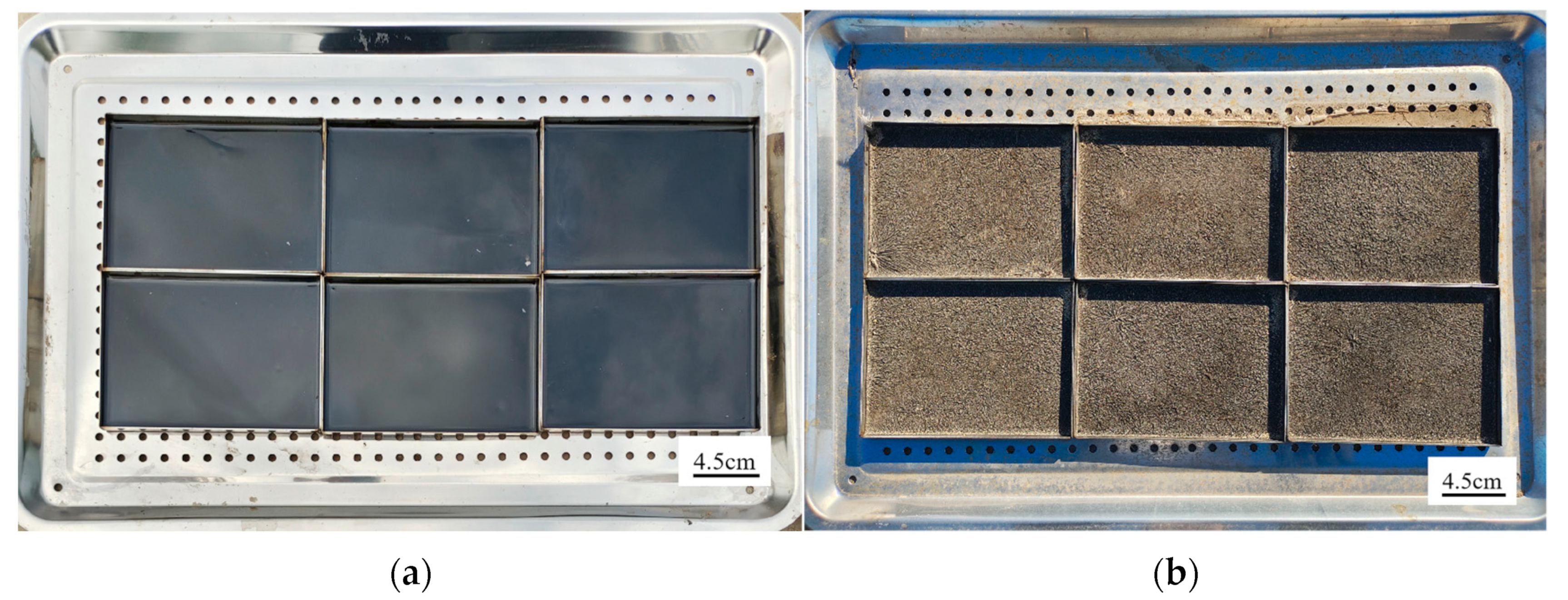
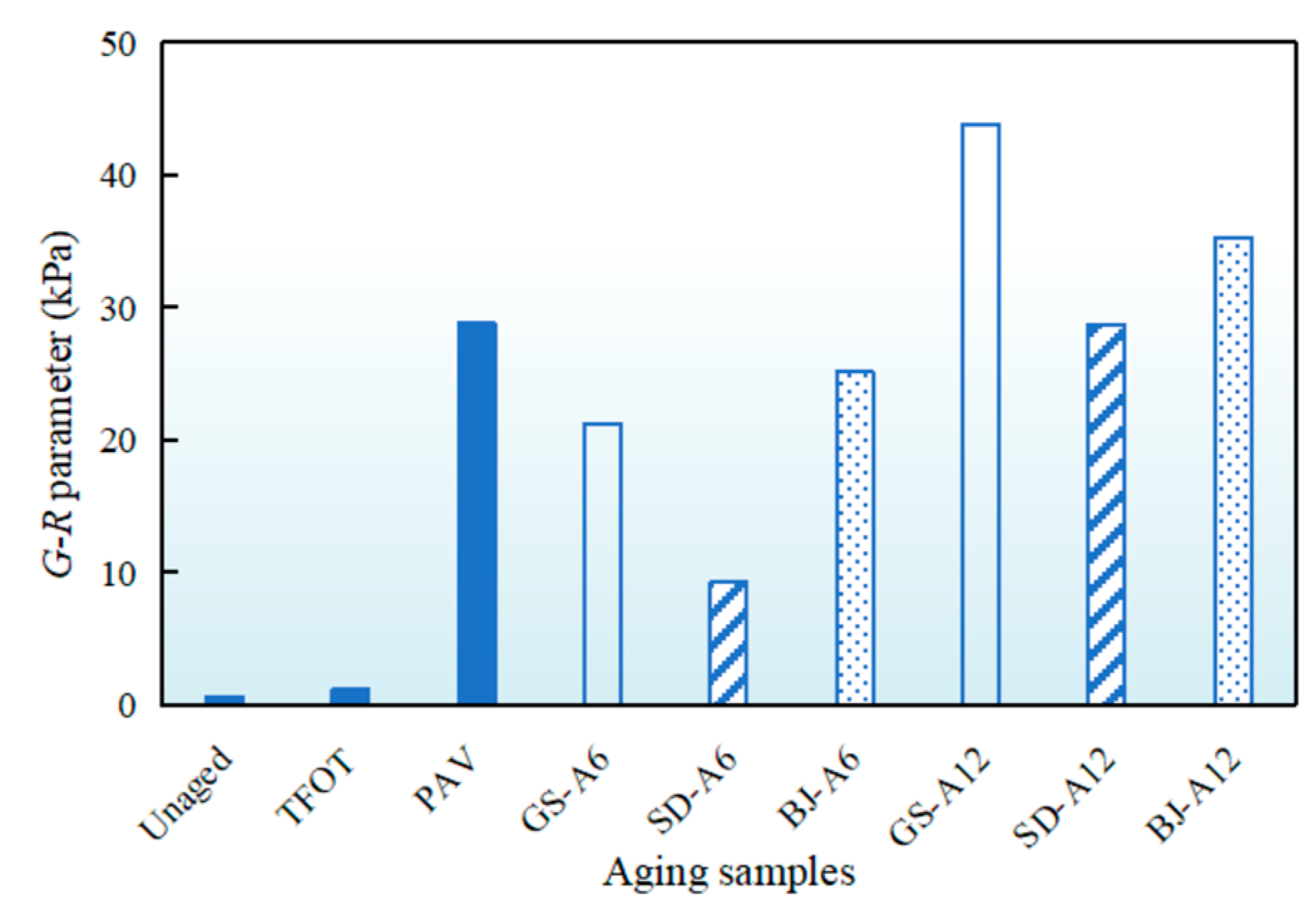
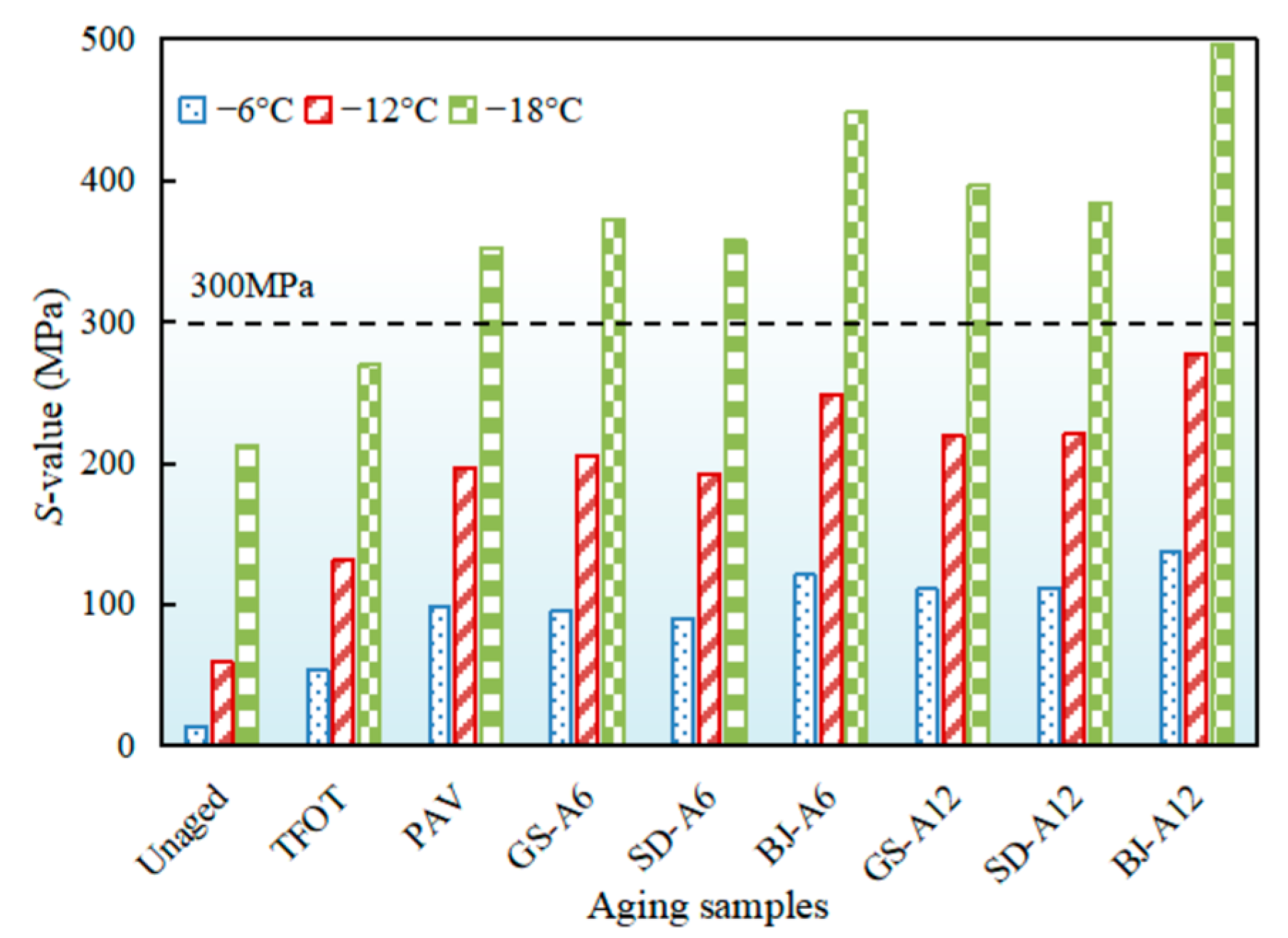
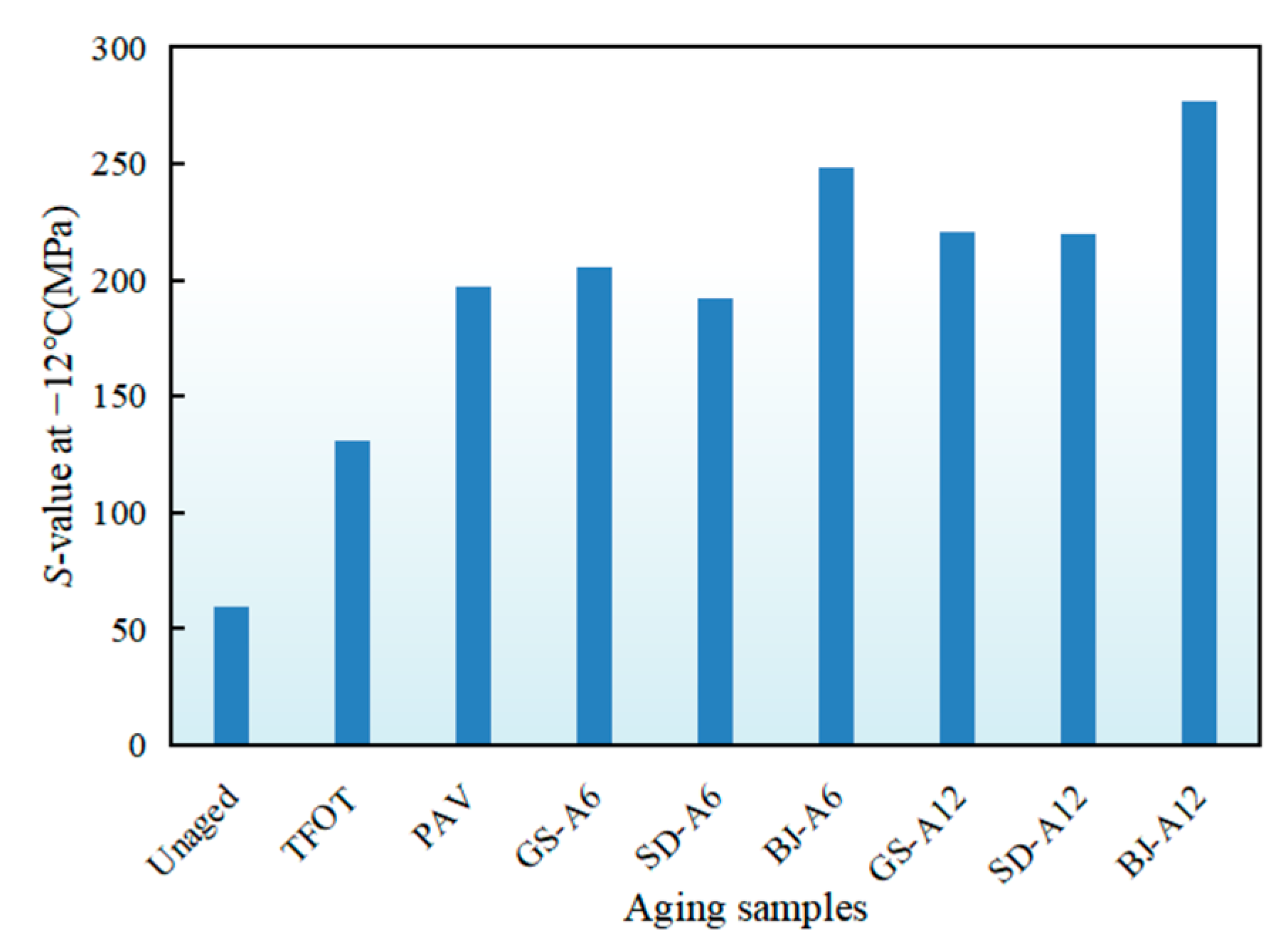
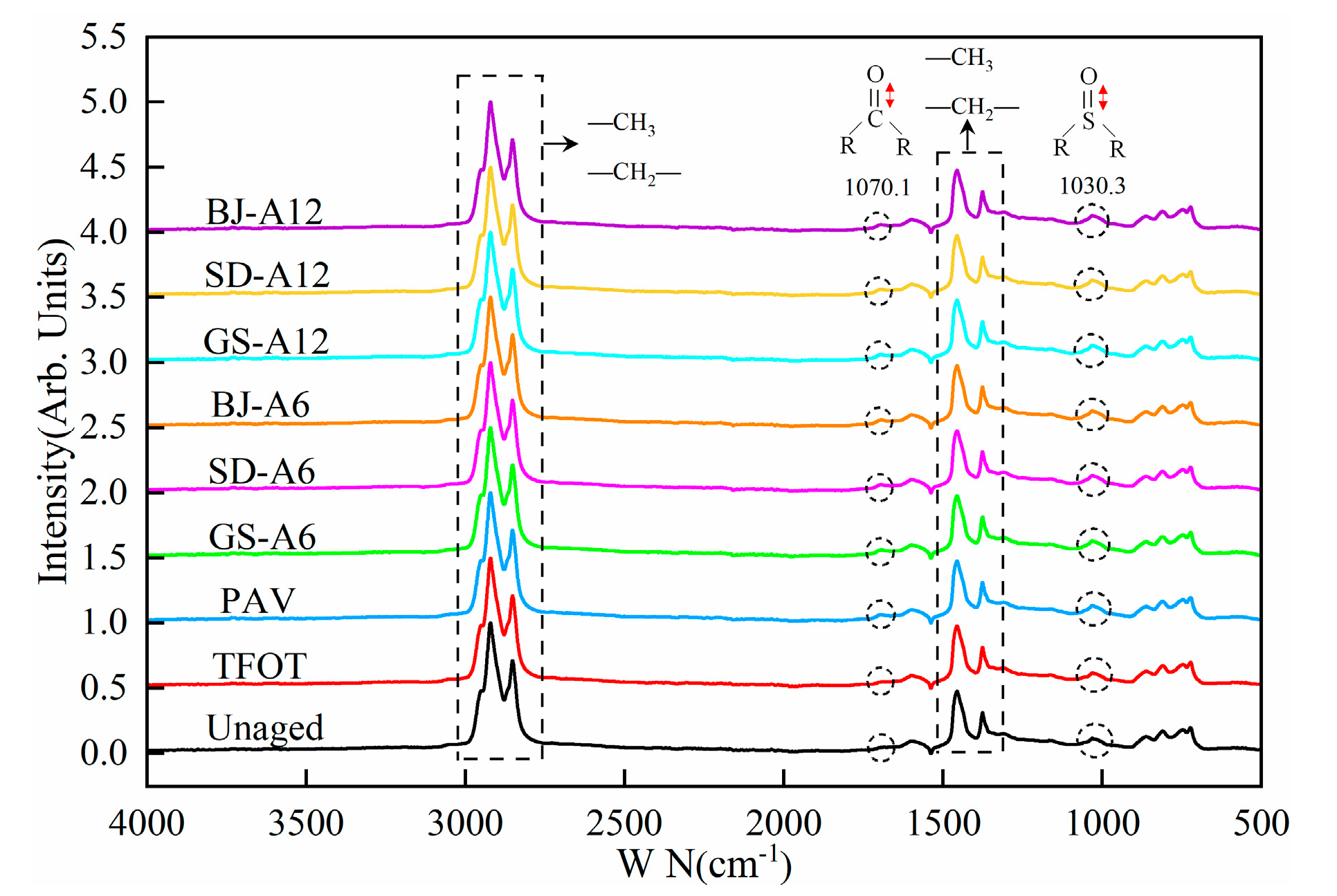
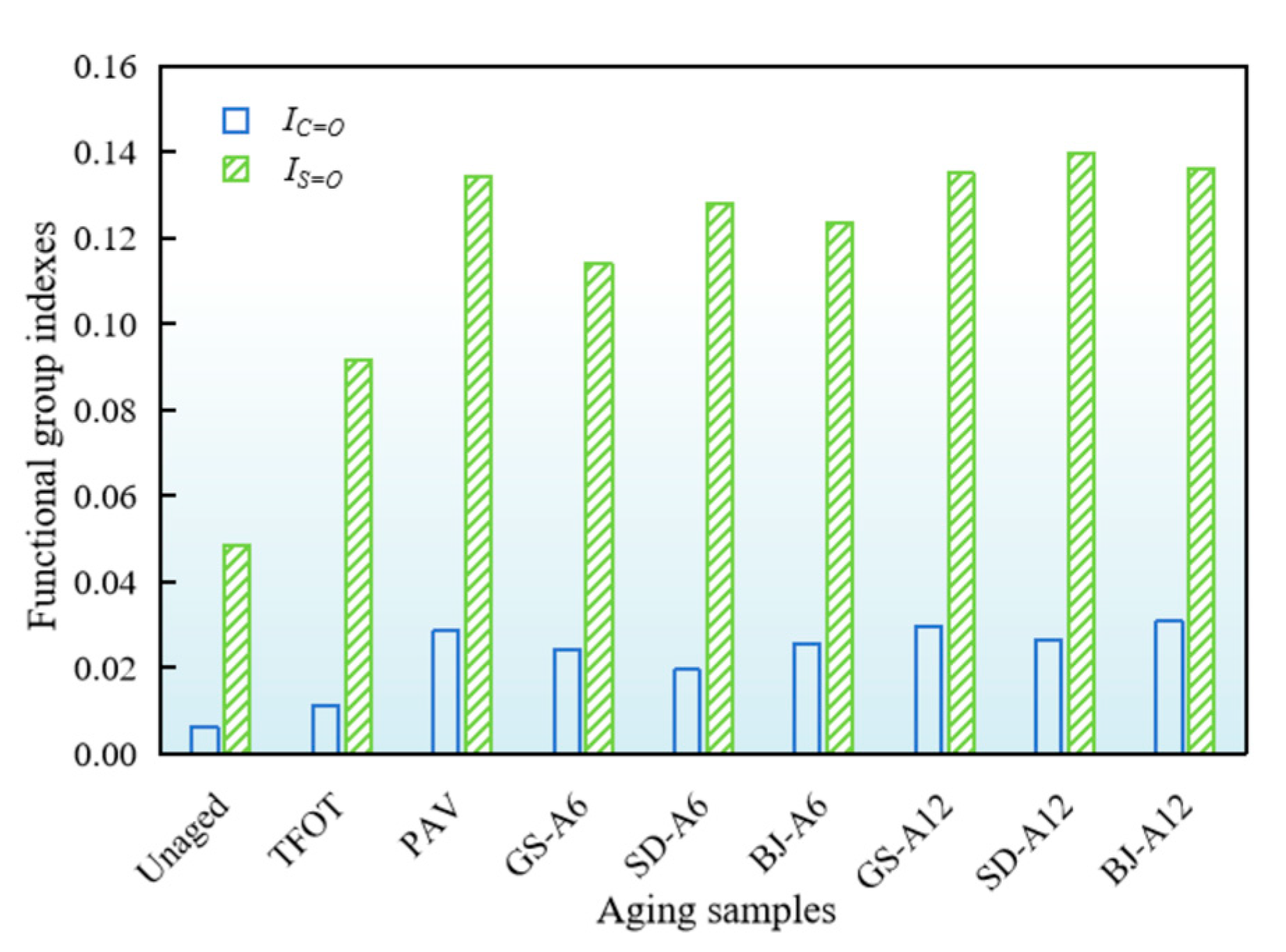
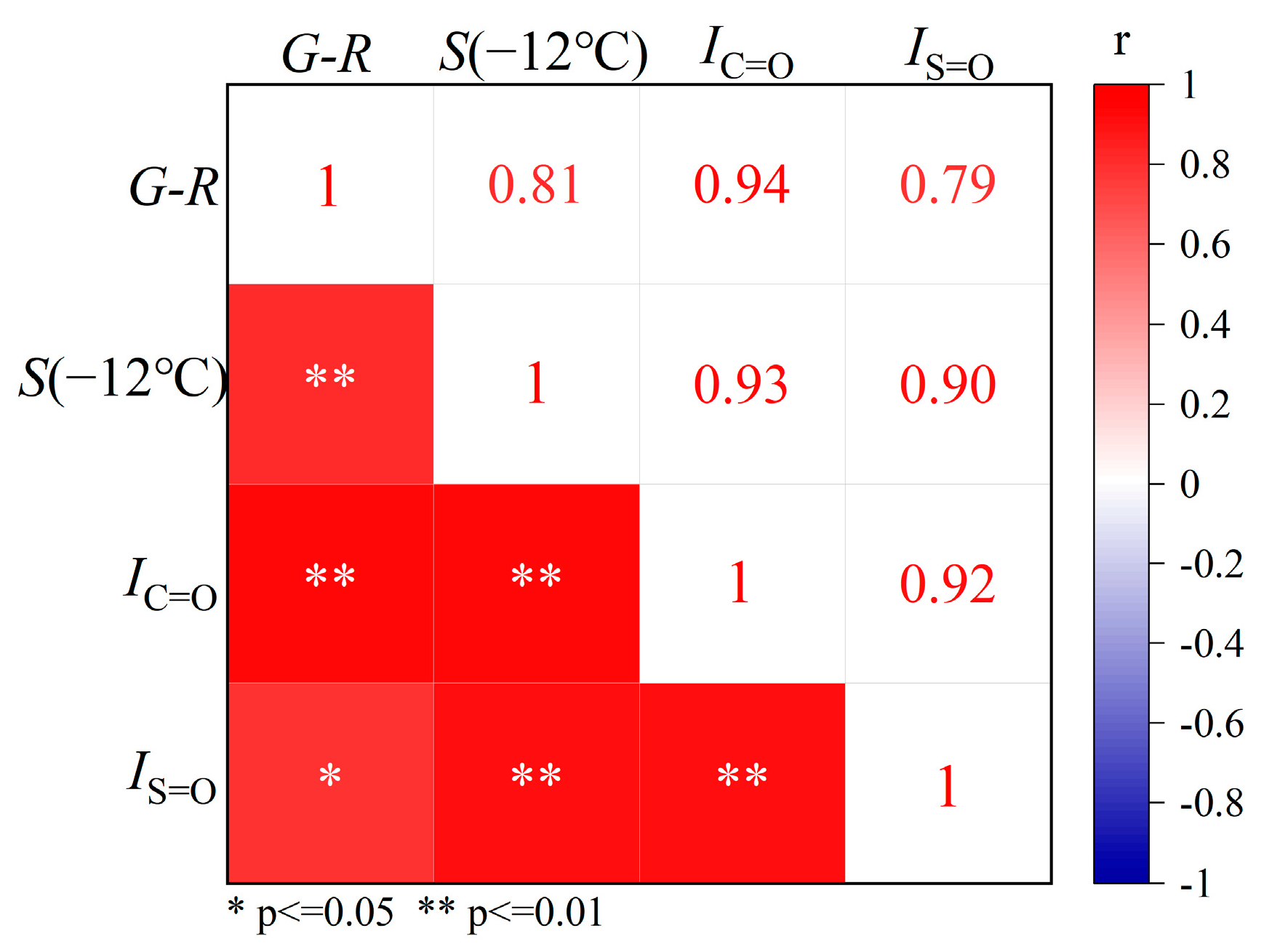

| Properties | Results | Standards | Methods |
|---|---|---|---|
| Penetration (25 °C, 100 g, 5 s)/0.1 mm | 81.8 | 80–100 | ASTM D5 [24] |
| Softening point (R&B)/°C | 46 | ≥44 | ASTM D36 [25] |
| Ductility (5 cm/min, 10 °C)/cm | 102 | ≥30 | ASTM D113 [26] |
| Viscosity (60 °C)/Pa·s | 144.5 | ≥140 | ASTM D4402 [27] |
| Abbreviation | Definition |
|---|---|
| Tmax-GS | Monthly average maximum temperature in Gansu |
| Tmin-GS | Monthly average minimum temperature in Gansu |
| Tmax-SD | Monthly average maximum temperature in Shandong |
| Tmin-SD | Monthly average minimum temperature in Shandong |
| Tmax-BJ | Monthly average maximum temperature in Beijing |
| Tmin-BJ | Monthly average minimum temperature in Beijing |
| Abbreviation | Definition |
|---|---|
| GS-A6 | Samples after 6-month all-weather aging in Gansu |
| GS-A12 | Samples after 12-month all-weather aging in Gansu |
| SD-A6 | Samples after 6-month all-weather aging in Shandong |
| SD-A12 | Samples after 12-month all-weather aging in Shandong |
| BJ-A6 | Samples after 6-month all-weather aging in Beijing |
| BJ-A12 | Samples after 12-month all-weather aging in Beijing |
| Abbreviation | Definition |
|---|---|
| MMTD | Monthly mean temperature difference |
| MMUVR | Monthly mean ultraviolet radiation |
| MMP | Monthly mean precipitation |
Disclaimer/Publisher’s Note: The statements, opinions and data contained in all publications are solely those of the individual author(s) and contributor(s) and not of MDPI and/or the editor(s). MDPI and/or the editor(s) disclaim responsibility for any injury to people or property resulting from any ideas, methods, instructions or products referred to in the content. |
© 2025 by the authors. Licensee MDPI, Basel, Switzerland. This article is an open access article distributed under the terms and conditions of the Creative Commons Attribution (CC BY) license (https://creativecommons.org/licenses/by/4.0/).
Share and Cite
Guo, M.; Dong, Y.; Yin, X.; Guan, M.; Liang, M.; Wang, X.; Du, X. Analysis of Regional Differences in Asphalt Binder Under All-Weather Aging Based on Rheological and Chemical Properties. Materials 2025, 18, 2829. https://doi.org/10.3390/ma18122829
Guo M, Dong Y, Yin X, Guan M, Liang M, Wang X, Du X. Analysis of Regional Differences in Asphalt Binder Under All-Weather Aging Based on Rheological and Chemical Properties. Materials. 2025; 18(12):2829. https://doi.org/10.3390/ma18122829
Chicago/Turabian StyleGuo, Meng, Yixiang Dong, Xu Yin, Mingyang Guan, Meichen Liang, Xudong Wang, and Xiuli Du. 2025. "Analysis of Regional Differences in Asphalt Binder Under All-Weather Aging Based on Rheological and Chemical Properties" Materials 18, no. 12: 2829. https://doi.org/10.3390/ma18122829
APA StyleGuo, M., Dong, Y., Yin, X., Guan, M., Liang, M., Wang, X., & Du, X. (2025). Analysis of Regional Differences in Asphalt Binder Under All-Weather Aging Based on Rheological and Chemical Properties. Materials, 18(12), 2829. https://doi.org/10.3390/ma18122829







